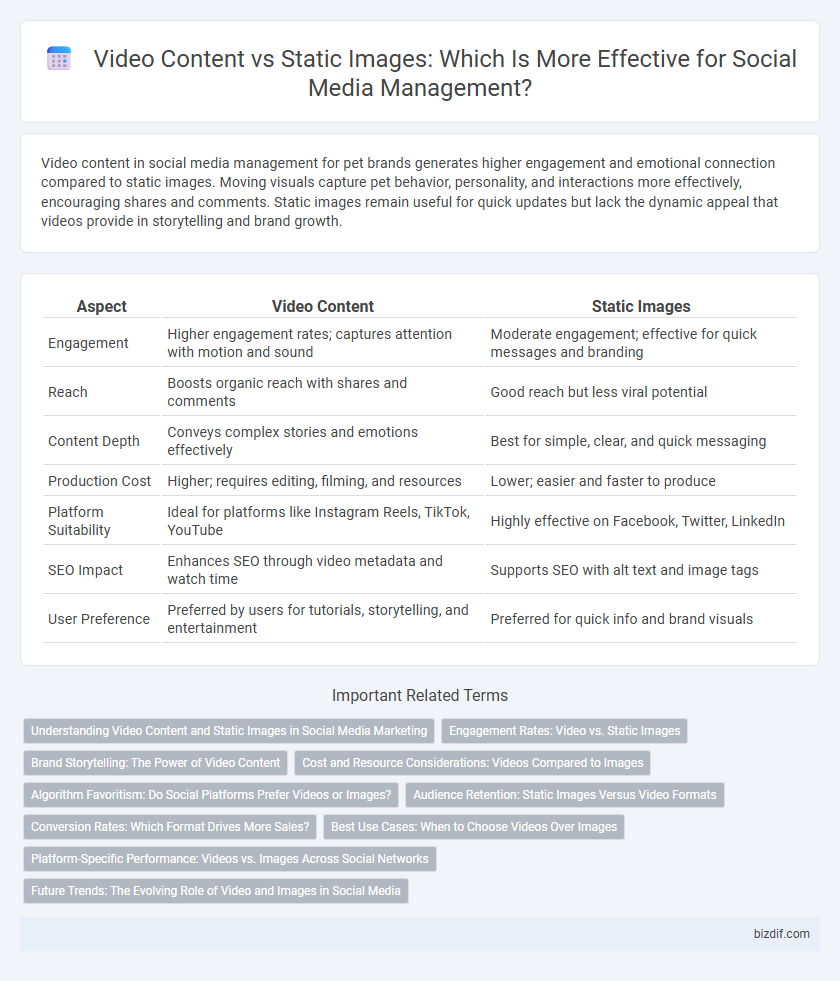Video content in social media management for pet brands generates higher engagement and emotional connection compared to static images. Moving visuals capture pet behavior, personality, and interactions more effectively, encouraging shares and comments. Static images remain useful for quick updates but lack the dynamic appeal that videos provide in storytelling and brand growth.
Table of Comparison
| Aspect | Video Content | Static Images |
|---|---|---|
| Engagement | Higher engagement rates; captures attention with motion and sound | Moderate engagement; effective for quick messages and branding |
| Reach | Boosts organic reach with shares and comments | Good reach but less viral potential |
| Content Depth | Conveys complex stories and emotions effectively | Best for simple, clear, and quick messaging |
| Production Cost | Higher; requires editing, filming, and resources | Lower; easier and faster to produce |
| Platform Suitability | Ideal for platforms like Instagram Reels, TikTok, YouTube | Highly effective on Facebook, Twitter, LinkedIn |
| SEO Impact | Enhances SEO through video metadata and watch time | Supports SEO with alt text and image tags |
| User Preference | Preferred by users for tutorials, storytelling, and entertainment | Preferred for quick info and brand visuals |
Understanding Video Content and Static Images in Social Media Marketing
Video content typically generates higher engagement rates and longer viewer retention compared to static images, making it a powerful tool for storytelling and brand awareness on social media platforms like Instagram, Facebook, and TikTok. Static images, however, are easier to produce, quickly convey messages, and perform well for concise promotions or brand aesthetics, especially on platforms like Pinterest and LinkedIn. Balancing video content with static images enables marketers to optimize audience reach and maintain consistent brand presence while leveraging the unique strengths of each format.
Engagement Rates: Video vs. Static Images
Video content generates significantly higher engagement rates on social media platforms compared to static images, with studies showing up to 120% more shares and comments. Videos capture user attention longer, boosting interaction metrics like likes and click-through rates due to dynamic visuals and storytelling elements. Brands leveraging video content report increased audience retention and improved algorithmic favorability, leading to greater organic reach and follower growth.
Brand Storytelling: The Power of Video Content
Video content enhances brand storytelling by delivering dynamic narratives that engage audiences through motion, sound, and emotion, creating a memorable and immersive experience. Unlike static images, videos provide a richer context that fosters deeper connections and drives higher retention rates, leading to increased brand recall and loyalty. Social media algorithms also favor video content, boosting organic reach and amplifying brand visibility across platforms.
Cost and Resource Considerations: Videos Compared to Images
Video content requires higher production costs and more time-intensive resources compared to static images, including specialized equipment, editing software, and skilled personnel. Static images offer a cost-effective alternative with quicker turnaround times and lower demand for technical expertise. Businesses often balance budget constraints with engagement goals by integrating a mix of both formats in their social media strategies.
Algorithm Favoritism: Do Social Platforms Prefer Videos or Images?
Social media algorithms increasingly prioritize video content due to higher user engagement metrics such as watch time and shares, boosting reach and visibility. Platforms like Instagram, Facebook, and TikTok favor videos in their feeds and stories, leveraging autoplay and interactive features to enhance user retention. While static images still perform well for quick consumption and brand aesthetics, videos dominate algorithmic preferences by driving deeper audience interaction.
Audience Retention: Static Images Versus Video Formats
Video content significantly improves audience retention on social media platforms, as dynamic visuals and motion capture attention more effectively than static images. Videos encourage longer viewing times and higher engagement rates, boosting algorithmic favorability and organic reach. While static images provide quick, easy-to-digest information, video formats drive deeper connection and sustained interest from followers.
Conversion Rates: Which Format Drives More Sales?
Video content significantly outperforms static images in driving higher conversion rates, with studies showing up to 80% increased purchase likelihood when videos are used in social media ads. Interactive video elements and storytelling effectively engage viewers, boosting brand trust and encouraging immediate action. Brands leveraging video content on platforms like Instagram and Facebook experience greater sales growth compared to those relying solely on static imagery.
Best Use Cases: When to Choose Videos Over Images
Videos outperform static images when conveying complex stories or demonstrating product features, as they engage viewers with motion and sound, increasing retention and emotional impact. Use videos for tutorials, behind-the-scenes content, and event coverage to create immersive experiences that drive higher interaction rates and conversions. Static images work best for quick announcements, brand consistency, and easily shareable posts where immediate visual impact is essential.
Platform-Specific Performance: Videos vs. Images Across Social Networks
Video content consistently outperforms static images on platforms like Instagram and Facebook, generating up to 38% more engagement due to its dynamic storytelling capabilities. LinkedIn favors video for professional content, with native videos receiving five times more shares than images, enhancing organic reach. Twitter shows higher click-through rates for videos, while Pinterest users engage more deeply with static images, highlighting the importance of tailoring content to platform-specific audience behavior.
Future Trends: The Evolving Role of Video and Images in Social Media
Video content is dominating social media engagement with predictions indicating 82% of all internet traffic will be video by 2024. Emerging technologies like augmented reality (AR) and livestreaming are enhancing video interactivity, making dynamic content more immersive and valuable for brands. Static images maintain relevance for quick consumption and branding, but the future shows a clear shift toward video-driven strategies to maximize reach and user engagement.
video content vs static images Infographic

 bizdif.com
bizdif.com